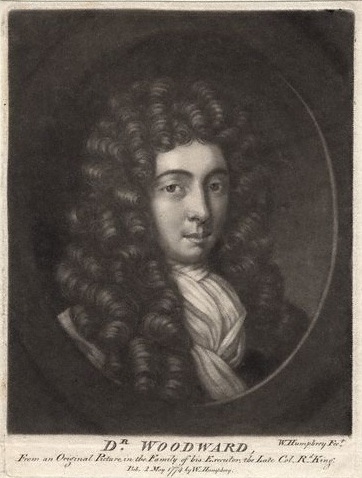
Mineralogy’s greatest curiosity was not how Dr. John Woodward (1665 - 1728, above) obtained a pallasite meteorite for his collection, decades before the meteorite was actually discovered in Siberia….
Also it was not how Britain’s first true volcanologist, Guglielmo Thompson (1760 - 1806), was ignored as the true discoverer of Widmanstätten patterns in the same meteorite, because of an incident with a rectal thermometer…..
In 1776, the greatest curiosity in mineralogy was the meteorite itself - The Pallas Iron. That year, the Academy of Sciences in St. Petersburg sent a fragment of this discovery to the British Museum. Exhibited in case 13, it was labelled as “A large cellular mass of native iron, with much of the olivine-like substance, from Siberia” by the museum. It was described as native iron because, to express the idea that it was extraterrestrial and had fell from the sky, would have caused laughter and derision from within the scientific community. This even with the knowledge that the “discoverer,” Mr. Medvedev, stated that local Tartars regarded the iron boulder as a sacred relic which had fallen from the sky.

It was not until 1794 that a scientist had the bottle to propose a cosmic origin for meteorites, when the German researcher Prof. Ernst F.F. Chladni (1756 - 1827, above, the father of acoustics) used the Pallas Iron as the prime example of aerolites. In 1798, the Philosophical Magazine published his paper, “Observations on a Mass of Iron found in Siberia by Professor Pallas.”
The Russian “Discovery” by Pallas

Under the reign of the Tsarina, Catherine the Great, Empress and Autocrat of All the Russias, the empire was revitalised. She enlisted the help of several experts to kickstart the age of the Russian Enlightenment, recruiting the scientists Leonhard Euler and Peter Simon Pallas from Berlin to the Russian capital.
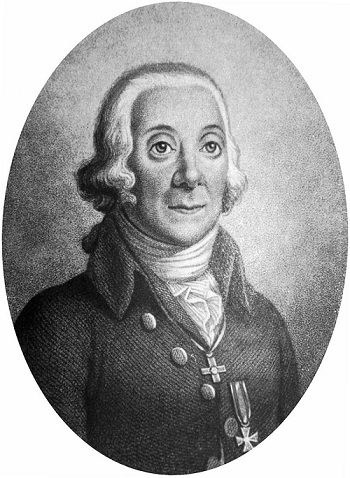
In 1767, Peter Pallas (1741 - 1811, above), Prussian zoologist and botanist, was invited by Catherine II of Russia to become a professor at the St Petersburg Academy of Sciences and, between 1768 and 1774, he led an expedition to central Russian provinces, Povolzhye, Urals, West Siberia, Altay, and Transbaikal, collecting natural history specimens for the academy.
He explored the Caspian Sea, the Ural and Altai Mountains and the upper Amur River, reaching as far eastward as Lake Baikal. The regular reports which Pallas sent to St Petersburg were collected and published as Reise durch verschiedene Provinzen des Russischen Reichs (Journey through various provinces of the Russian Empire), covering a wide range of topics, including geology and mineralogy.
In 1772, Pallas obtained a 680-kg lump of metal that had been found near Krasnoyarsk, where he had been wintering. It had been discovered in 1749 (when Pallas was only 8 years old), on a mountain east of the river Jenisei, in between its two tributaries Ubei and Sisim. The finders were a local resident Jacob Medvedev and a German miner, Johann Caspar Mettich.
Pallas recognised the highly unusual nature of the mass of iron, and soon had it shipped to St. Petersburg. He distributed many samples of the enigmatic mass to achemedicians and museums worldwide, and had this to say about the iron -

“The greatest curiosity in mineralogy, discovered in the district of Krasnojarsk, is an enormous mass of pure iron, weighing 40 puds, or near 1500lb. on which I shall expatiate a little. This most curious mass was discovered in 1750, on a mountain where they made a trying-pit for iron-ore, and where it lay on the surface, but not then thought worthy of notice. Among the miners who made the discovery, was a Mr. John Mettich, who gave me the following account of the situation of this iron-mass, in writing. "In 1749, a reformed Cossack, an inhabitant of Ubeiskaja, announced a hard iron ore at the top of a high mountain (describing that where the mass stood). This iron-ore stood lode-like, on a little rock-shelf, turned to the north. I was sent to examine it, and found it on an assay, to have gold alloy. The lode stood in a hard, chert-like, grey matrix, of which the whole mountain seemed to consist. About 150 fathoms south-west from this spot, I observed, at the top of the mountain, thinly over-grown with red and white firs, a lump of iron, apparently above 30 puds in weight, full of yellow, hard, little stones, of the size of a cedar-nut, which could not be knocked out. This, and the sound, appeared to me remarkable; yet I cannot say it grew thus naturally, or whether it was brought there, as it was lying, on day, on the surface of the ground. On a strict examination, I found no traces of old mine-works, or smelting-hearths, throughout the whole extent of the mountain. I know, that this Cossack afterwards carried the lump away; but what is become of it, I cannot tell."
The Cossack, who is now a blacksmith, could not tell the exact situation, or place, where this iron lump lay; but what he said, was probably agreeable to what Mr. Mettich wrote down. He averred, that it lay quite on the surface, on the top of the mountain, without being encompassed with any other cliff or strata. He also assured me, that he never found any mark of an old smelt-hearth, or work, neither on this, nor on the opposite mountain. But as the malleability and white∣ness of the iron, and the sonorous found of the lump, made him suspect it might contain some more noble metal than common iron; and his suspicions being still increased by the Tartars, who considered it as a sacred thing fallen from heaven, he endeavoured, as no works were ordered, after having announced this one, to convey it to his dwelling, at 32 miles distance, which he did with the greatest difficulty.
I received information of this piece of massive iron, in November 1771, by a Tartarean soldier, who was very useful to me in collecting matters relative to natural history. This soldier entered by chance the house of the above. Cossack who found the iron, and seeing it in his yard, it struck him as a curiosity. Knocking off, with great trouble, a few, little pieces, he brought them to me for an assay; but as this assay, though imperfect, seemed very ferruginous, I ordered the soldier to go, without delay, to the village where this man lived, which was 170 miles distant from Krasnojarskaja, and bring me the whole mass, which weighed above 42 puds.
The whole seems to have been encompassed by a raw, ferruginous crust, which was lost by hammering it, to knock off some pieces. The whole, internal part consists of a slender, white iron, interspersed with little holes, or cells, like a sea-sponge; and the interstices filled with round and oblong drops, of a yellow, transparent and pure glass, or hyacinthus-flux. These drops have various, oblong, round shapes, and a very smooth surface, with one, two, three, or more flat sides, about the truncated part of their rounded bodies, which flow often together, with other drops. This texture and drops are from the size of a grain of hemp-seed, to a large pea, and either of a pure yellow, or a yellow-brown, or greenish colour, and are uniform throughout the mass, without any appearance of smelting, or artificial fire. The iron is so tough, that three or four smiths were working a whole forenoon, to knock off a piece from one of its corners; though such piece weighed seldom more than a pound or two, except one piece that weighed a pud, and was sent, for assay, to the Academy of Sciences at Petersburgh. By the blows, the flux is reduced into a kind of glass-dust, and often falls out in whole drops, with which glass might be cut. In short, the whole mass, and each piece cut out from it, proves incontestably that this huge production came out of Nature's lap.”
One scientist who investigated the Pallas Iron was Guglielmo Thomson (1761 - 1806), an Englishman based at the University of Naples. Having obtained a specimen of Pallas’ “find,” he proceeded to work on it, and published his results, including these diagrams of the fine patterns etched into the structure by his application of nitric acid -
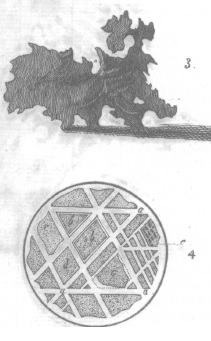
From “Essai sur le fer malléable trouve en Siberie par le Prof. Pallas” G. Thomson, 1804
His 1804 work was largely ignored, and credit for the discovery of the etch figures produced by nitric acid or bromine on polished meteorites went to Count Alois von Beckh Widmanstätten (1753 - 1849). Even though Widmanstätten revealed the structures (using a bunsen burner, not acid) 4 years after Thomson, and didn’t publish. The beautiful crystalline structure of the nickel-iron was revealed as a fine interleaving of kamacite and taenite lamellae, showing the very, very slow cooling of the mass of liquid metal. Widmanstätten patterns should rightly be called Thomson structures.
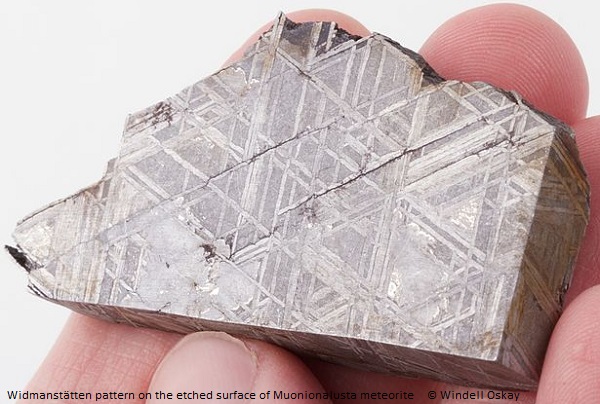 Thomson structures, on a Scandinavian iron
Thomson structures, on a Scandinavian iron
Why Guglielmo Thomson’s work was ignored, and after his death, his fine collection of 10,000 volcanic rocks and mineral specimens refused by Oxford University (they went to Edinburgh Uni), is not absolutely clear. But it could be because of a misunderstanding (he maintained) about his experimental use of an anal thermometer in 1786, with the assistance of local bookseller Mr. Fletcher’s servant boy. Thomson usually worked with cadavers. Whatever happened, William Thomson (as he was then known) was banished from Oxford Uni in Sept 1790 for “foedissini et sodomitici criminis” and immediately moved to Italy with a new name.
Pallasite meteorites are amongst the most intriguing of objects. As well as the Thomson structures showing a cooling rate of a few degrees per million years, the peridot gem-quality olivine crystals, which are much less dense than the nickel-iron, are somewhat evenly distributed within the metal. This shows that the solidification took place in a low gravity environment. Pallasites were formed within protoplanets with a radius of around 200 km. Collisions between these objects disintegrated them, the fragments from the molten iron dynamo core / mantle interface becoming pallasites.
In 1980, Russian scientists commemorated the discovery of the Pallas iron by mounting a cast-iron disk, two meters across and stamped with a design showing a fireball and a fallen iron, at the likely find site -

In the video below, the main mass of the Pallas Iron is shown, as sawn in half by von Kokscharow, displayed at Fersman’s Museum, Moscow -
Considering the rarity of pallasite meteorites (only 61 falls known), it seems rather unlikely that another would turn up in Russia, near to a town named after Peter Pallas…

The Pallasovka meteorite is a pallasite, named after a town, named after the discoverer of pallasites! The 198kg meteorite was discovered in 1990 by a local, Mr. Kharitonov, about 17 miles from the town named after the German naturalist, after he’d visited the area in 1774. This meteorite is not part of the possible strewn field of the Pallas Iron (now known as the Krasnoyarsk meteorite).

Specimens of the 1749 Krasnoyarsk meteorite are occasionally for sale. The above 2.5 × 1.8 × 0.9 cm fragment sold through e-Rocks for $180.

The Woodwardian Collection Connection
Finally we get to John Woodward (1665 - 1728, above). “A vain, foolish and affected man,” Woodward was reviled by most of his contemporaries, but laid the foundations for much geological progress, and created a magnificent, fully described collection.
He thrived on intellectual conflict, which occasionally led to a confrontation, and Woodward was not averse to “a bit of frisk.” He was debating with Dr. Mead in 1719. They held opposing views on whether purging or vomiting was the best cure for smallpox, and an argument broke out -
“Last week Dr Mead and Dr Woodward, both belonging to Gresham College, in walking down Bishopsgate-street quarrelled and caned one another; and when they came into the Square of the College, they drew and fought; the latter was wounded in several Places, and making another Pass, Dr Woodward fell down backwards, and the other gave him his Life.” (The Mist’s Journal, June, 13, 1719)
When the professor of Physic at Gresham College was not duelling with swords (over two remedies sure to shorten the life of a smallpox victim), he found time to conduct experiments in hydroponics, published in 1713 a treatise on a 16th century shield obtained from a London scrap-man, which he authoritatively identified, unfortunately incorrectly, as Roman, and produced learned tomes such as An Essay toward a Natural History of the Earth and Terrestrial Bodies, especially Minerals, &c. and The State of Physick and of Diseases ... Particularly of the Smallpox.
His greatest achievement, however, was his collection of minerals and fossils. Whereas his contemporaries, such as bitter rival Dr. Hans Sloane, collected anything unusual, much in the tradition of the “Cabinets of Curiosity” of antiquity, Woodward collected only those things deemed intellectually of value and interest. He meticulously labelled 10,000 specimens in five beautiful walnut cabinets. In his elaborate Catalogue he described his rocks, minerals and fossils in a manner far in advance of the age. He died on the 25th of April 1728, and was buried in Westminster Abbey.
He bequeathed his collection to the University of Cambridge. The Woodwardian Collection forms the basis of the present day Sedgwick Museum. For several decades following his death, the collection languished somewhat, until its treasures became apparent. In 1768 some unusually hard mineral specimens arrived in Scotland from India.
“Mr Berry a lapidary in Edinburgh received a box of it from Dr Anderson of Madras. Dr Black ascertained that these specimens differed from all the stones known to Europeans and in consequence of its hardness it obtained the name of adamantine spar.”
It wasn’t until 1784 when a certain Mr. Greville obtained some specimens from India, with information that the locals called the stone corundum. And then it was noticed that specimens of corundum had been present, catalogued, named and described, in the Woodwardian Collection since 1719, forgotten for 65 years.
So too, with the specimen of the Krasnoyarsk meteorite in the Woodwardian Collection. Forgotten until Pallas distributed samples of “his” find, and the Woodwardian Professor of Geology at Cambridge, Reverend Professor John Hailstone FRS (1759-1847), received a specimen in the 1780s. He immediately saw that the “Pallas Iron” had identical morphology and properties to the specimen of Siberian native iron in Woodward’s collection. Hailstone had the two specimens displayed side by side in the collection, as a testimonial to Woodward’s perspicacity and skills of acquisition.
Woodward died 1728… But Medvedev didn’t discover the Krasnoyarsk meteorite until 1749……

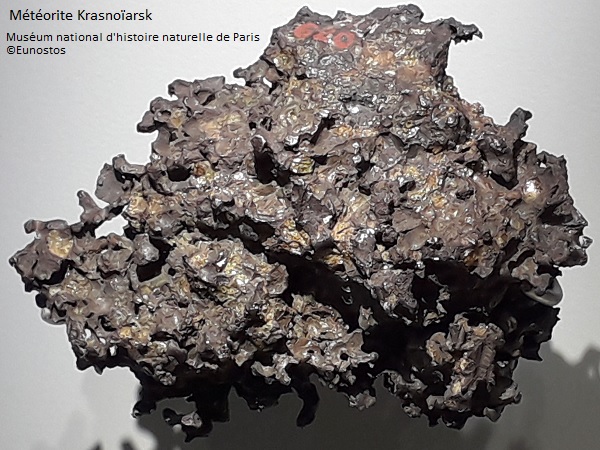
Looking at the above Krasnoyarsk fragment illustrations, note that they do not appear to have been hacked off a main mass with a saw or chisel. This is the case for the majority of specimens in museums worldwide. There is compelling evidence that fragments of the Krasnoyarsk meteorite were removed from the strewn field both by Medvedev, and before him by local Tartars, to be traded long, long before Pallas was even born.
References -
Account of the Iron Ore lately found in Siberia, Simon Pallas, 1775
Observations on a Mass of Iron found in Siberia by Professor Pallas, Prof. Chladni, 1798
Pallas Iron (pallasite Krasnojarsk) considered as Part of a Strewn-Field, Holger Pedersen, 2018
Ernst Florens Friedrich Chladni (1756–1827) and the origins of modern meteorite research, Ursula B. Marvin, 2007
Essai sur le fer malléable trouvé en Sibérie par le Prof. Pallas, Guglielmo Thompson, 1804
Formation of Stony-Iron Meteorites in Early Giant Impacts, Scott, Goldstein & Yang, 2010
Medical Laughter and Medical Polemics: The Woodward − Mead Quarrel and Medical Satire, Sophie Vasset, 2013
On the Corundum Stone from Asia, Rt. Hon. Charles Greville, FRS, 1798
And Now For Something Completely Different